Bosch OVEN User Manual [en, es, fr]

Installation Instructions
Guide d'installation
Manual de instalación
Slide-in Electric Ranges with European Convection
fr |
Cuisinières électriques à encastrer |
es |
Estufas eléctricas empotrables |

Table of Contents
Safety . . . . . . . . . . . . . . . . . . . . . . . . . . . . . . . . . . . . . . . . . . . . . . . . . . . . . 1
Installation . . . . . . . . . . . . . . . . . . . . . . . . . . . . . . . . . . . . . . . . . . . . . . . . . 2
Before You Begin . . . . . . . . . . . . . . . . . . . . . . . . . . . . . . . . . . . . . . . . . . . . . . . . . . . . . . . . . . . . . 2
Installation Procedure . . . . . . . . . . . . . . . . . . . . . . . . . . . . . . . . . . . . . . . . . . . . . . . . . . . . . . . . . . 7
Service . . . . . . . . . . . . . . . . . . . . . . . . . . . . . . . . . . . . . . . . . . . . . . . . . . . 15
Before Calling Service . . . . . . . . . . . . . . . . . . . . . . . . . . . . . . . . . . . . . . . . . . . . . . . . . . . . . . . . . 15
Questions?
1-800-944-2904
www.boschappliances.com
5551 McFadden Ave.
Huntington Beach, CA 92649
We look forward to hearing from you!

Safety
IMPORTANT SAFETY INSTRUCTIONS
READ AND SAVE THESE INSTRUCTIONS
Important Safety
Instructions
•Warning: If the information in this manual is not followed exactly, fire or shock may result causing property damage or personal injury.
•WARNING: Do not repair or replace any part of the appliance unless specifically recommended in the manuals. Improper installation, service or maintenance can cause injury or property damage. Refer to this manual for guidance. All other servicing should be done by a qualified technician.
Appliance Handling Safety |
• Do not lift appliance by door handle. Remove the door for easier handling and |
|
installation. See instructions in Use and Care Manual. |
|
• Unit is heavy and requires at least two people or proper equipment to move. |
|
• Hidden surfaces may have sharp edges. Use caution when reaching behind |
|
or under appliance. |
Safety Codes and Standards |
• This appliance complies with one or more of the following Standards: |
|
UL 858, The Standard for the Safety of Household Electric Ranges |
|
UL 923, The Standard for the Safety of Microwave Cooking Appliances |
|
UL 507, The Standard for the Safety of Electric Fans |
|
ANSI Z21.1-2000, The American National Standard for Household Cook- |
|
ing Gas Appliances |
|
CAN/CSA-C22.2 No. 113-M1984 Fans and Ventilators |
|
CAN/CSA-C22.2 No. 61-M89 Household Cooking Ranges |
|
It is the responsibility of the owner and the installer to determine if addi- |
|
tional requirements and/or standards apply to specific installations. |
Electric Safety |
• Before you plug in an electrical cord, be sure all controls are in the OFF posi- |
|
tion. |
|
• For appliances equipped with a cord and plug, do not cut or remove the |
|
ground prong. It must be plugged into a matching grounding type receptacle |
|
to avoid electrical shock. If there is any doubt as to whether the wall recepta- |
|
cle is properly grounded, the customer should have it checked by a qualified |
|
electrician. |
|
• If required by the National Electrical Code (or Canadian Electrical Code), this |
|
appliance must be installed on a separate branch circuit. |
|
• Only a power-supply cord kit rated for this appliance and marked "for use with |
|
ranges" shall be used. |
|
• Installer - show the owner the location of the circuit breaker or fuse. Mark it for |
|
easy reference. |
|
• Important - Save these instructions for the local electrical inspector's use. |
|
• Before installing, turn power OFF at the service panel. Lock service panel to |
|
prevent power from being turned ON accidentally. |
|
• Be sure your appliance is properly installed and grounded by a qualified tech- |
|
nician. Installation, electrical connections and grounding must comply with all |
|
applicable codes. |
Related Equipment Safety |
• Warning: All ranges can tip. Injury to persons could result. Install anti-tip |
|
device packaged with range. Verify that the anti-tip devices are engaged. See |
|
installation instructions. |
|
English 1 |

•Remove all tape and packaging before using the appliance. Destroy the packaging after unpacking the appliance. Never allow children to play with packaging material.
•Never modify or alter the construction of the appliance. For example, do not remove leveling legs, panels, wire covers or anti-tip brackets/screws.
•To eliminate the risk of burns or fire by reaching over heated surface units, cabinet storage space located above the surface units should be avoided. If cabinet storage is to be provided, the risk can be reduced by installing a hood that projects horizontally a minimum of 5 inches beyond the bottom of the cabinet.
•Verify that cabinets above the cooktop are a maximum of 13" (330 mm) deep.
Installation
Before You Begin
Tools and Parts Needed |
• |
40 or 50 Amp Power Supply Cord Kit (depending on local code) |
|
|
Note: Not necessary for Canadian installations |
|
• |
Measuring Tape |
|
• |
Phillips Head Screwdriver |
|
• 1-1/4” (31.8 mm) Wrench |
|
|
• |
Pencil |
|
• |
T-20 Torx Screwdriver |
|
• Screws (2) and Anchors (2) for Anti-Tip Bracket (Style will vary depending on |
|
|
|
mounting surface) |
|
• |
Level |
|
• Drill and Drill Bit |
|
|
• |
Soapy Water |
|
• Safety Gloves and Goggles |
|
|
• |
Tape (Optional) |
|
• Cloth or Cardboard (Optional - to Protect Floor) |
|
Additional Parts Needed For |
• |
Flexible Conduit |
Hard Wire Installations |
• |
Torque Wrench |
|
• Note: Power Supply Cord Kit Not Necessary For Hard Wire Installations |
|
Parts Included |
• |
Anti-Tip Bracket |
|
• |
Foam Tape |
|
• Terminal Lugs (For Use With Hard Wire Installations) (not necessary for |
|
|
|
Canadian installations) |
English 2

General Information
Overall Dimensions |
|
|
|
|
|
|
|
|
|
|
|
|
Table 1: Overall Dimensions |
|
|
|
|
|
|
||||
|
|
|
|
|
|
|
|
|
|
|
|
|
Dimension |
Inches |
centimeters |
||||||||
|
|
|
|
|
|
|
|
|
|
|
|
|
Height |
36 |
|
91.44 cm |
|
|
|
||||
|
|
|
|
|
|
|
|
|
|
|
|
|
Width |
29 5/16” |
74.55 cm |
|
|
|
|||||
|
|
|
|
|
|
|
|
|
|
|
|
|
Depth |
25 5/8” |
65.09 cm |
|
|
|
|||||
|
|
|
|
|
|
|
|
|
|
||
Level |
For best results, cabinets, countertops walls and floors in the installation location |
||||||||||
|
should be as level and plumb as possible. Variance may cause damage to coun- |
||||||||||
|
tertops and floors during installation, could jeopardize the seal around the cooktop |
||||||||||
|
and may adversely affect cooking and baking performance. |
||||||||||
Tips |
Tape warming drawer shut to keep it from opening while installing the range. |
||||||||||
|
During installation, place a portion of the box or a piece of cloth under the range to |
||||||||||
|
protect floors. |
|
|
|
|
|
|
|
|
||
|
To make range lighter and easier to handle remove door (see instructions in Use |
||||||||||
|
and Care manual). |
|
|
|
|
|
|
|
|
||
Preparation |
|
|
|
|
|
|
|
|
|
|
|
Electrical Requirements |
Refer to data plate for more information. See “Product Data Plate” on page 17 for |
||||||||||
|
data plate location. |
|
|
|
|
|
|
|
|
||
|
We recommend that the range be installed with a power cord set (not supplied).1 |
||||||||||
|
The electrical rating of the power cord set must be 120/240 volt, 40 or 50 amperes |
||||||||||
|
minimum (depending on local code). The power cord set shall be marked “For |
||||||||||
|
Use with Ranges.” Always use a new power cord. |
||||||||||
|
Note: In Canada, the range is shipped from the factory with the range cord |
||||||||||
|
already installed. |
|
|
|
|
|
|
|
|
||
|
Ranges are dual rated for use on either 120/240 VAC or 120/208 VAC. Check the |
||||||||||
|
data plate for the kW rating. Reference the kW rating in the table below to deter- |
||||||||||
|
mine amperage requirements. |
|
|
|
|
|
|
||||
|
Table 2: Electrical Specifications |
|
|
|
|
|
|
||||
|
|
|
|
|
|
|
|||||
|
kW Rating |
Hz |
Amps Req’d |
||||||||
|
|
|
|
|
|
|
|
|
|||
|
120/240V |
120/208V |
|
|
|
|
|
|
|||
|
|
|
|
|
|
|
|
|
|
|
|
|
13 |
|
|
9.8 |
|
60 |
|
|
40 or 50a |
|
|
|
13.8 |
|
|
10.4 |
|
60 |
|
|
40 or 50a |
||
a. Varies by location. Check local codes.
1.Not needed for Canadian installations
English 3
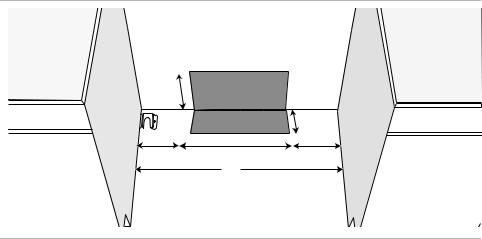
The electrical outlet must be located in the shaded space in Figure 3.
7 1/2”
(190.5 mm)
|
|
3 1/2” |
|
|
(88.9 mm) |
4 1/2” |
21” (533.4 mm) |
4 1/2” |
(114.3 mm) |
30” |
(114.3 mm) |
|
|
|
|
(762 mm) |
|
|
Figure 1: Cooktop Clearances |
|
Verify that wiring to house is adequate |
|
Contact your local utility company to verify that the present electric service to your |
|
home is adequate. In some instances, the size of the wiring to the house and ser- |
|
vice switch must be increased to handle the electrical load demanded by the |
|
range. |
|
Verify that wiring inside house is adequate |
|
Most wiring codes require a separate circuit with separate disconnect switch and |
|
fuses either in the main entrance panel or in a separate switch and fuse box. |
|
The range requires a minimum of a three wire 120/240 or 120/208 volt, 40 or 50 |
|
AMP, 60 Hz AC circuit. Check local codes for proper amperage ratings.A four wire |
|
connection is preferred. |
|
Most local building regulations and codes require that electrical wiring be done by |
|
licensed electricians. Be sure to install your range according to the electric codes |
|
in place in your region. |
Cabinet Requirements |
This unit is designed for installation near adjacent walls and projecting surfaces |
|
constructed of combustible materials. |
English 4
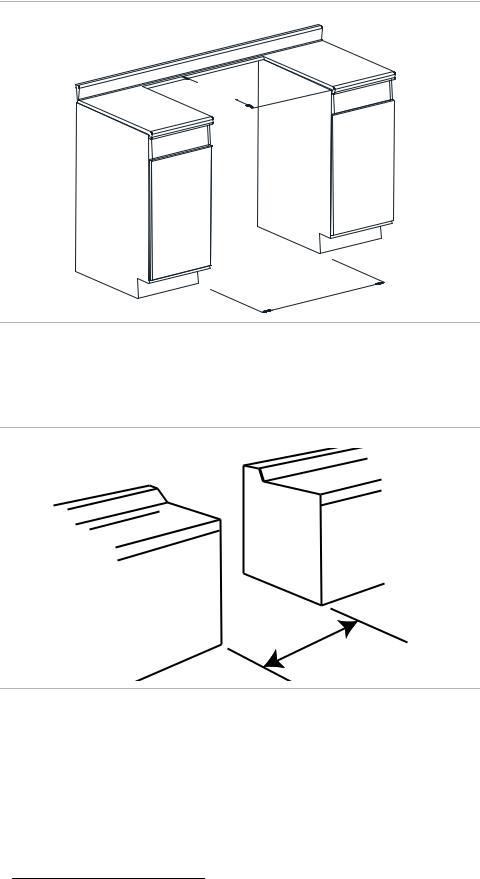
Allow a minimum of 30 inches between cabinets where range is to be installed1. See Figure 2: Cutout Requirements for more information..
 23 1/16" (585.4 mm)
23 1/16" (585.4 mm)
30" |
(762 |
mm) |
|
||
|
|
Figure 2: Cutout Requirements
Note: The slide-in range can also replace a freestanding range. In this case, verify that the opening is at least 30 inches.1
30" (76.2 cm) min.
Figure 3: Cutout Requirements - Replacing a Free-Standing Model
1.In Canada, a clearance of 12 mm from range sidewall to cabinet is required.
English 5

Countertop Requirements
Mounting Requirements
English 6
|
30" (76.2 cm) |
|
|
min. centered |
|
4" (10.2 cm) |
30" (76.2 cm) min. |
4" (10.2 cm) |
min. |
|
min. |
no clearance required
(12 mm clearance required in Canada)
Figure 4: Cabinet Preparation
Required Clearance1
From cooktop to materials above: There must be a minimum clearance of 30 inches between the top of the cooking surface and the bottom of an unprotected wood or metal cabinet. See Figure 4: Cabinet Preparation.
24 inches is acceptable when the bottom of the wood or metal cabinet is protected by (a) not less than 1/4" of flame retardant material which must be covered with
(b) not less than No. 28 MSG sheet metal, 0.015 inch stainless steel’ or 0.024 inch aluminum or copper.
From range walls to adjacent materials: See Figure 4: Cabinet Preparation. No clearance is required from unit walls to adjacent vertical combustible walls on
rear, right or left.2
Clearance from range top to adjacent vertical walls must be at least 4”.
Note: Some cabinet finishes cannot survive the temperatures allowed by U.L., particularly self-cleaning ovens; the cabinets may discolor or stain. This is most noticeable with laminated cabinets.
Prepare Walls and Floor
Seal any holes in the walls or floor. Remove any obstructions (extra electrical or gas connections, etc.) so that range will rest against wall properly.
Countertops must be smooth and level.
Install Anti-Tip Bracket
1.Instructions were determined using standard American cabinets. Standard base cabinets measure 36" high x 24" deep. Cabinets over the cooking surface and cabinets adjacent to those over the cooking surface measure 13 inches deep from backwall. If nonstandard cabinets are used, care should be taken to alter dimensions accordingly.
2.In Canada, a clearance of 12 mm from range sidewall to cabinet is required.
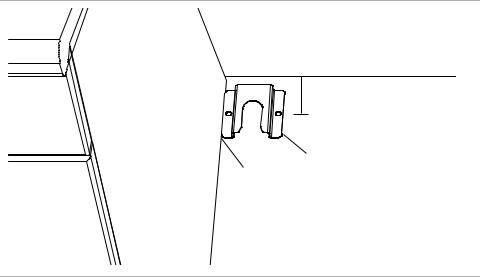
1.Adjust height of range and level by rotating the adjustable leg supports on the bottom of the range, using 1-1/4" wrench.
2.Measure to locate bracket position as shown in See Figure 5: Anti-Tip Bracket.
3.Secure bracket with 2 screws adequate for mounting surface (i.e., for wood floor use wood screws, for concrete floor use concrete anchors and screws).
|
rearwall |
cabinet wall |
1 9/16" (39.7 mm) |
|
from rear wall to center of screw hole |
|
floor |
|
anti-tippin g |
|
device |
|
flush against |
|
cabinet wall |
|
Figure 5: Anti-Tip Bracket |
Ventilation Recommendations |
We strongly recommend the installation of a ventilation hood above this appli- |
|
ance. For most kitchens a certified hood rating of not less than 300 CFM is recom- |
|
mended. The range hood must be installed according to instructions furnished |
|
with the hood. |
Installation Procedure
Apply Foam Tape
Install Backwall Trim
Apply foam tape to underside of cooktop trim in one continuous piece.
Note: DO NOT use caulk or glue/adhesive of any kind.
Note: This step is only required if the countertop does not connect behind the range (i.e.; when replacing a free-standing range). See “Cabinet Requirements” on page 6 for more information
English 7
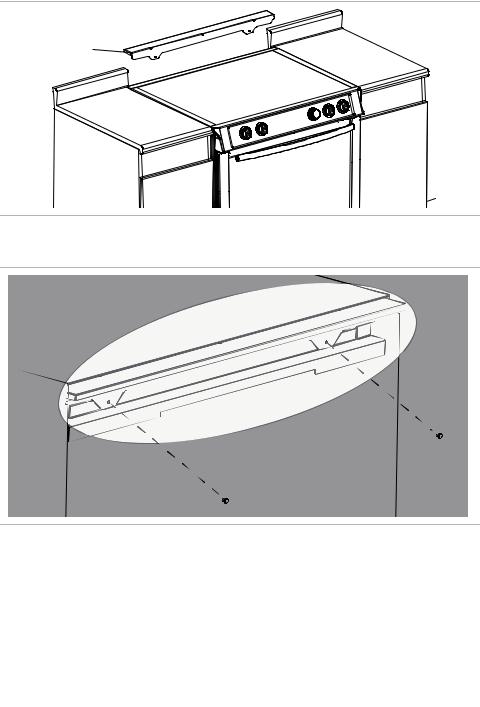
Install 2 screws through holes in trim and in range backwall. See Figure 6: Backwall Trim Strip and Figure 7: Install Backwall Trim Strip
Backwall
Trim Strip
Figure 6: Backwall Trim Strip
Back of Range
Connect Electric - Range
Cord
Install Strain Relief
Figure 7: Install Backwall Trim Strip
Note: In Canada, the range is shipped from the factory with the range cord already installed. Continue to “Complete the installation” on page 15.
For installations other than those in Canada, connect the range cord at the terminal block (See next page for detailed instructions). Access the terminal block by removing the cover in the lower right hand corner of the range back panel.
 Warning: The strain relief provided with your range cord must be properly installed.
Warning: The strain relief provided with your range cord must be properly installed.
Place strain relief in knockout below terminal block. See Figure 8: Strain Relief Knockout. Feed range cord through hole and strain relief up to terminal block. Allow for slack in the cord between the strain relief and terminal block. Once cord
English 8
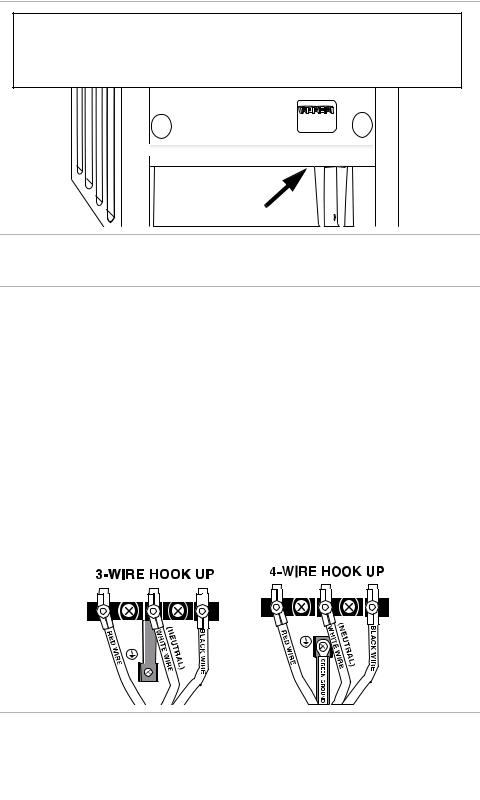
length/ slack has been adjusted, attach strain relief per instructions included with strain relief.
Tip: The knockout panel below the terminal block can be removed from the range to install the strain relief: Remove knockout panel from range, install strain relief in panel and reattach. DO NOT remove entire range back panel.
Figure 8: Strain Relief Knockout
 Warning: Risk of Electric Shock or Fire. Frame grounded to neutral
Warning: Risk of Electric Shock or Fire. Frame grounded to neutral
through a ground strap. Grounding through the neutral conductor is prohibited for new branch-circuit installations (1996 NEC), mobile homes, and recreational vehicles, or in an area where local codes prohibit grounding through the neutral conductor.
For installations where grounding through the neutral conductor is prohibited,
(a) disconnect the link from the neutral, (b) use grounding terminal or lead to ground unit, (c) connect neutral terminal to lead branch circuit neutral in usual manner (when the appliance is to be connected by means of a cord kit, use 4- conductor cord for this purpose).
Use only cord kits rated 125/250 volts (minimum), 40 or 50 amperes (depending on local code) and labeled “For Use with Ranges”. Strain relief provided with cord must be installed per instructions
Figure 9: Grounding Requirements
 Warning: To prevent electrical shock, the grounding prong on the range
Warning: To prevent electrical shock, the grounding prong on the range
cord should not be cut or removed under any circumstances. It must be plugged into a matching grounding type receptacle and connected to a correctly polarized 240Volt circuit. If there is any doubt as to whether the wall receptacle is properly grounded, have it checked by a qualified electrician.
English 9
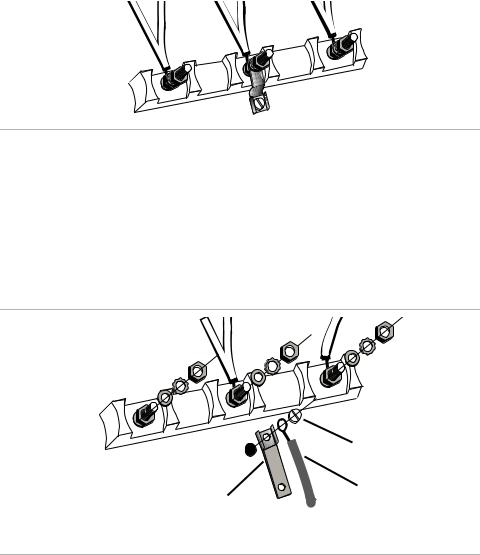
Four Wire Range Cord Connection |
1. |
Disconnect electrical power at breaker box. |
(Recommended Method) |
2. |
Remove the terminal block cover to expose the terminal block |
Figure 10: 4 Wire Connection
3. Remove top nut, star washer, and round washer from each post.
Note: DO NOT remove last round washer, last nut or internal wiring leads.
4.Remove screw from bottom end of ground strap.
5.Remove ground strap from center post, rotate so that wide end is at top and attach wide end to range through hole below junction box. Attach green wire on top of ground strap. Tighten Screw.
green ground screw
ground wire
ground strap
Figure 11: Four Wire Range cord Connection - Ground Strap and Wire
6.Attach red wire, round washer, star washer and nut IN THIS ORDER to left post.
7.Attach white wire, round washer, star washer and nut IN THIS ORDER to center post.
English 10
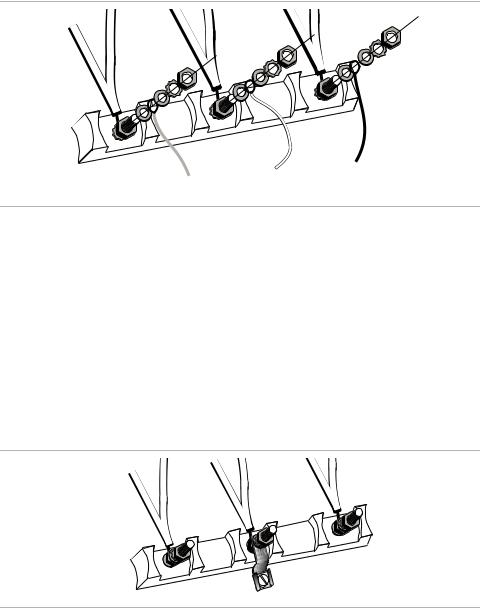
8.Attach black wire, round washer, star washer and nut IN THIS ORDER to right post.
black
white
red
Figure 12: Four Wire Range Cord Connection (continued)
9.Tighten all connections securely and replace terminal block cover.
10.Properly secure strain relief (see previous section).
Note: DO NOT plug in range at this time.
Three Wire Range Cord Connection The Four Wire Connection (above) is preferred, but where local codes and ordinances permit grounding through neutral and where conversion to four wire is impractical, the unit may be connected to the power supply via a three wire connection.
1.Disconnect electrical power at breaker box.
2.Remove the terminal block cover to expose the terminal block.
Figure 13: Terminal Block
3. Remove top nut, star washer, and round washer from each post.
Note: DO NOT remove last round washer, last nut or internal wiring leads.
4.Attach white wire, round washer, star washer and nut IN THIS ORDER on top of ground strap on center post.
5.Attach red wire, round washer, star washer and nut IN THIS ORDER to left post.
English 11
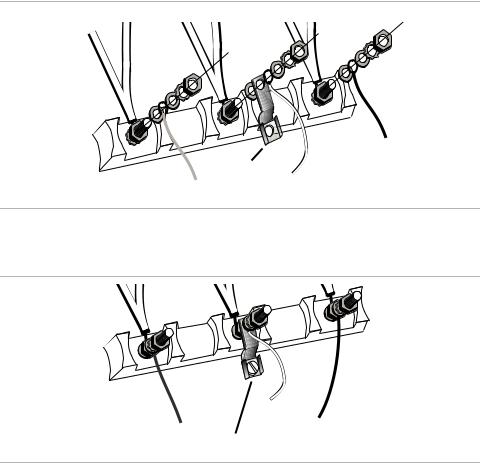
6.Attach black wire, round washer, star washer and nut IN THIS ORDER to right post.
black
ground strap
white
red
Figure 14: Three Wire Connection
7. Tighten all connections securely and replace terminal block cover.
green ground screw
Figure 15: Completed Three Wire Range Cord Connection
Connect Electric - Flexible
Conduit Connection
Four Wire Flexible Conduit Connection
8.Properly secure strain relief. See “Install Strain Relief” on page 8 for detailed instructions.
The range can also be connected via flexible conduit. If using this method, always use the lugs supplied.
Note: In Canada, the range is shipped from the factory with the range cord already installed. Continue to “Complete the installation” on page 15.
1.Disconnect electrical power at the breaker box.
2.Remove the terminal block cover to expose the terminal block.
3.Remove the top nut, star washer, and round washer from each post.
Note: DO NOT remove last round washer, last nut or internal wire leads.
4.Remove screw from bottom end of ground strap.
5.Remove ground strap from center post. Discard.
6.Attach one terminal lug (packaged with this manual) through hole below terminal block with ground screw.
7.Place one terminal lug (packaged with this manual) on each post. Replace the star washer and round washer and secure with 20 inch pounds of torque.
English 12
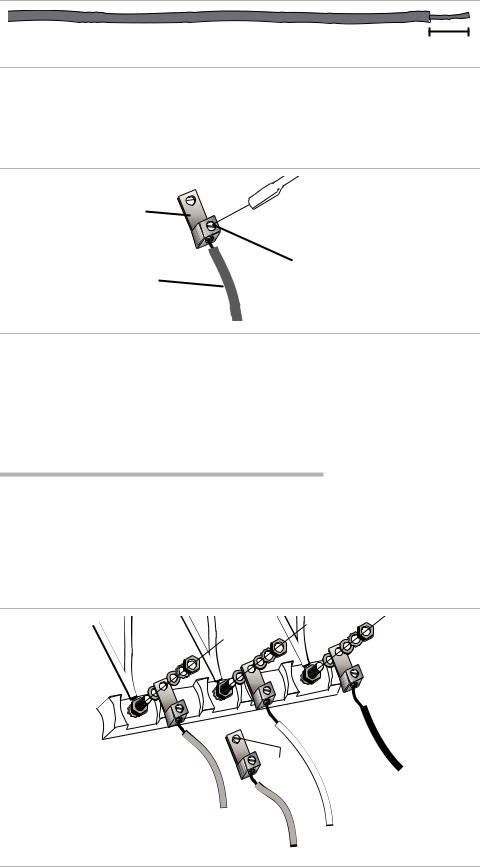
8. Strip 3/8 (9.53 mm) inches of insulation from the end of the wire.
3/8 “
Figure 16: Wire Stripping
9.Insert the insulated grounding wire into the lug below the terminal block.
10.Insert stripped end of white wire into the center lug. Secure the clampingscrew.
lug
clamping screw
wire
Figure 17: Attaching Wire to Lug
11.Insert stripped end of red wire into the left lug. Secure clamping screw.
12.Insert black wire into the right lug. Secure clamping screw. Tighten each clamping screw with the appropriate torque (see table).
Table 3: Appropriate Torque Levels for Aluminum or Copper Wire
Gauge |
|
Torque (in./lbs.) |
|
Torque (Nm) |
|
|
|
|
|
6 |
35 |
3.95 |
||
|
|
|
|
|
8 |
25 |
2.82 |
||
|
|
|
|
|
13.Properly secure flexible conduit at knockout on angle and at supply side junction box. The wiring is now complete.
green
ground black wire screw
red wire
white wire
green ground wire
Figure 18: Completed Four Wire Flexible Conduit Connection
English 13
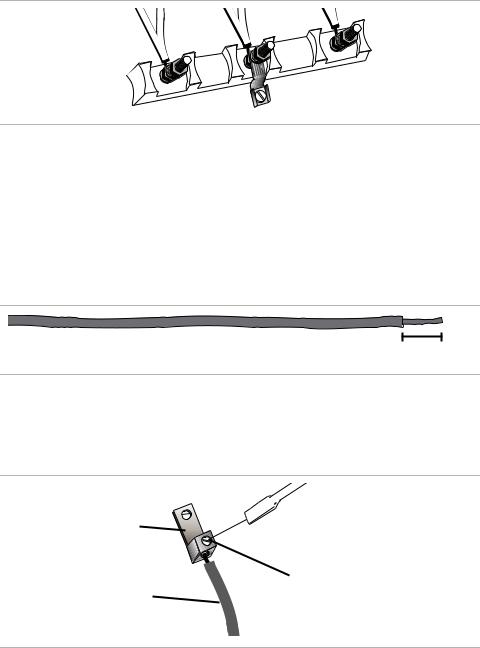
Note: DO NOT plug in range at this time.
Three Wire Flexible Conduit Connection
The Four Wire Connection is preferred, but where local codes and ordinances permit grounding through neutral and/or conversion to four wire is impractical, unit may be connected to the power supply via a three wire connection.
1.Disconnect electrical power at the breaker box.
2.Remove the terminal block cover to expose the terminal block.
Figure 19: Terminal Block
3. Remove the top nut, star washer, and round washer from each post.
Note: DO NOT remove last round washer, last nut or internal wire leads.
4.Place one terminal lug (packaged with this manual) on each post. Replace the star washer and round washer and secure with 20 inch pounds of torque.
5.Strip 3/8 (9.53 mm) inches of insulation from the end of each wire.
3/8 “
Figure 20: Wire Stripping
6.Insert stripped end of white wire into the center lug on top of the ground strap. Secure the clamping screw.
.
lug
clamping screw
wire
Figure 21: Attaching Wire to Lug
7.Insert stripped end of red wire into the left lug. Secure clamping screw.
8.Insert stripped end of black wire into the right lug. Secure clamping screw.
English 14
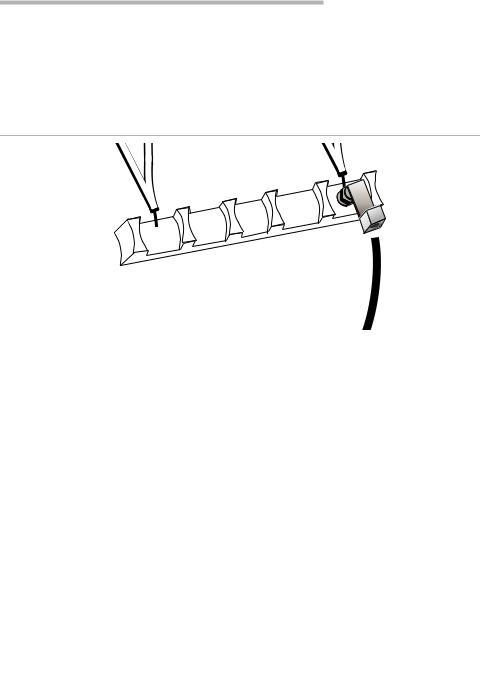
9. Tighten each clamping screw with the appropriate torque (See table below).
Table 4: Appropriate Torque Levels for Aluminum or Copper Wire
Gauge |
|
Torque (in./lbs.) |
|
Torque (Nm) |
|
|
|
|
|
6 |
35 |
3.95 |
||
|
|
|
|
|
8 |
25 |
2.82 |
||
|
|
|
|
|
10.Properly secure flexible conduit at knockout panel on range and at supply side junction box. The wiring is now complete.
|
|
green ground screw |
|
|
|
|
|
Figure 22: Completed Three Wire Flexible Conduit Connection |
|
Note: DO NOT plug in range at this time. |
|
Complete the installation |
|
|
Adjust Levelling Legs |
1. |
Line up range in front of opening. |
|
2. |
Measure back left corner of opening from floor to top of countertop. |
|
3. |
Measure back left corner of range to bottom of cooktop trim. Use a wrench to |
|
|
adjust leveling leg until this height is the same as the corner dimension. |
drawer
|
|
wrench |
|
|
adjustable leg |
|
|
|
|
|
Figure 23: Adjust the Front Leveling Leg |
|
4. |
Repeat in right back corner. |
|
5. |
Adjust front leveling legs so that the bottom of the cooktop trim is ½" higher |
|
|
than the corresponding countertop surface. |
Slide Range into Opening |
1. |
Plug in power cord. |
|
2. |
Dampen countertop and foam tape with soapy water. |
English 15
